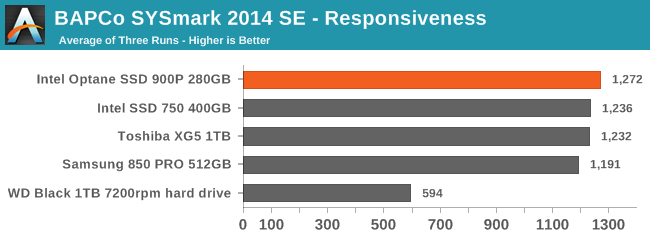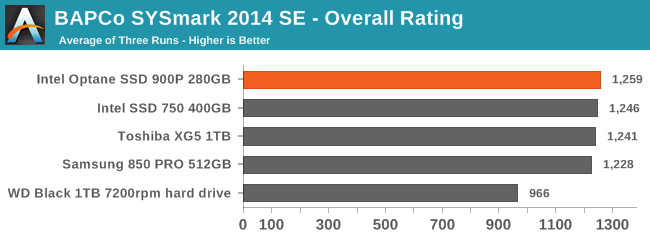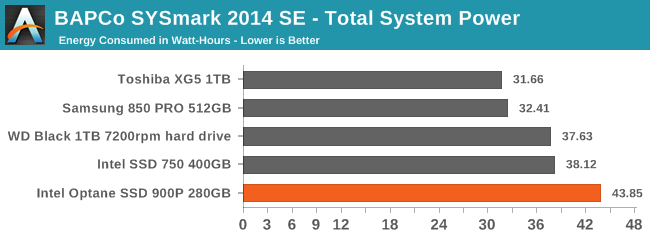The Intel Optane SSD 900P 280GB Review
by Billy Tallis on October 27, 2017 9:30 AM ESTBAPCo SYSmark 2014 SE
BAPCo's SYSmark 2014 SE is an application-based benchmark that uses real-world applications to replay usage patterns of business users in the areas of office productivity, media creation and data/financial analysis. In addition, it also addresses the responsiveness aspect which deals with user experience as related to application and file launches, multi-tasking etc. Scores are calibrated against a reference system that is defined to score 1000 in each of the scenarios. A score of, say, 2000, would imply that the system under test is twice as fast as the reference system.
SYSmark scores are based on total application response time as seen by the user, including not only storage latency but time spent by the processor. This means there's a limit to how much a storage improvement could possibly increase scores, because the SSD is only in use for a small fraction of the total test duration. This is a significant difference from our ATSB tests where only the storage portion of the workload is replicated and disk idle times are cut short to a maximum of 25ms.
| AnandTech SYSmark SSD Testbed | |
| CPU | Intel Core i5-7400 |
| Motherboard | ASUS B250-PLUS |
| Chipset | Intel B250 |
| Memory | 2x 8GB Kingston DDR4-2400 CL17 |
| Case | In Win C583 |
| Power Supply | Cooler Master G550M |
| OS | Windows 10 64-bit, version 1703 |
Our SSD testing with SYSmark uses a different test system than the rest of our SSD tests. This machine is set up to measure total system power consumption rather than just the drive's power.


SYSmark 2014 SE doesn't come close to stressing the storage system enough to show meaningful distinctions between high-end NVMe SSDs. The Responsiveness sub-test is the most sensitive to storage performance, and only shows a few percent difference between most SSDs. The overall test barely registers a difference at all. But with my primary power meter broken, SYSmark does provide a rough assessment of how power hungry the Intel Optane SSD 900P is:

The SYSmark energy usage scores measure total system power consumption, excluding the display. Our SYSmark test system idles at around 26 W and peaks at over 60 W measured at the wall during the benchmark run. SATA SSDs seldom exceed 5 W and idle at a fraction of a watt, and the SSDs spend most of the test idle.
Despite being the fastest drive in this bunch and thus the one with the shortest SYSmark run times, the Optane SSD 900P used far more energy over the course of the three SYSmark runs. With higher idle power than even the Intel SSD 750 and similar power draw under load, the Optane SSD 900P really needs its heatsink. Intel is a very long way off from being able to package this level of performance in a M.2 SSD.










205 Comments
View All Comments
Lolimaster - Saturday, October 28, 2017 - link
Optane seems like a Joke not only in endurance, performance, but not power consumption too. Right now it's basically a bot for random 4K, you don't really need that, get the 960EVO/PRO.Lolimaster - Saturday, October 28, 2017 - link
*now.AnnonymousCoward - Saturday, October 28, 2017 - link
Why are you saying get the 960 PRO? It costs double a normal SSD and performs the same in real-world. Please enlighten me.SunnyNW - Saturday, October 28, 2017 - link
Would system start-up be any faster?Lolimaster - Saturday, October 28, 2017 - link
Probably yes since it has higher random 4k read and latency. Wanna check the limit, search those old ramdisk booting times. Above that we would need a boot disk of L3 cache memory class, then one made up of L2 cache memory class, edram, etc.Lolimaster - Saturday, October 28, 2017 - link
Till you reach L1 cache memory class or sram."Bullwinkle J Moose" - Saturday, October 28, 2017 - link
That depends....How fast is Fast?
I've seen people bragging on youtube that their new 90+ Watt Quadcore Intel CPU will boot Win 10 to an M.2 EVO drive in 17-20 seconds....
But my 35 Watt dualcore Sandy bridge will boot Windows 10 Fall Crappers Edition (Sept 2017) to an 850 Pro in 5.35 seconds.....
or, the same machine will boot Windows XP-SP2 to the same 850 Pro in 3 - 4 seconds (Varies sleightly every boot)
So, how fast is fast?
jabber - Saturday, October 28, 2017 - link
Good luck to the couple of dozen or so that will be able to make proper use of this and notice a difference over a 850 EVO .Pork@III - Saturday, October 28, 2017 - link
Do fast? Yes it is fast. Has volume? - Nope.I maked install of operation system and come to install FM7 on 128GB SSD and instalator say me: "not enough space". :(
nOOky - Saturday, October 28, 2017 - link
The 280 gig drive is priced similarly to the Samsung 830 Pro 256 gig when it came out if you're thinking the price is outrageous...